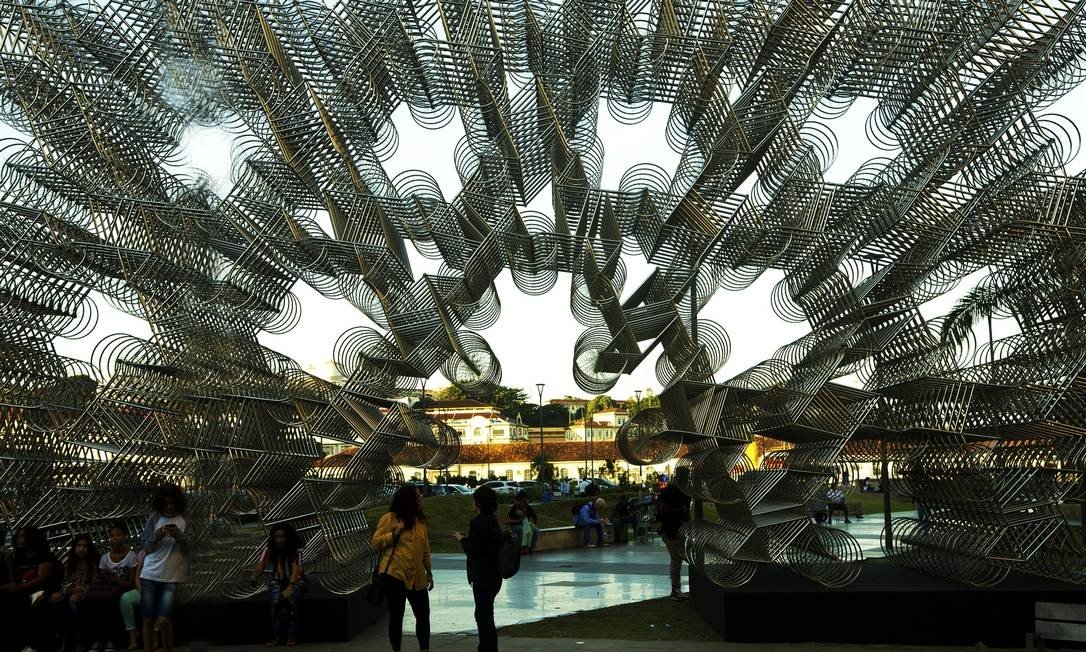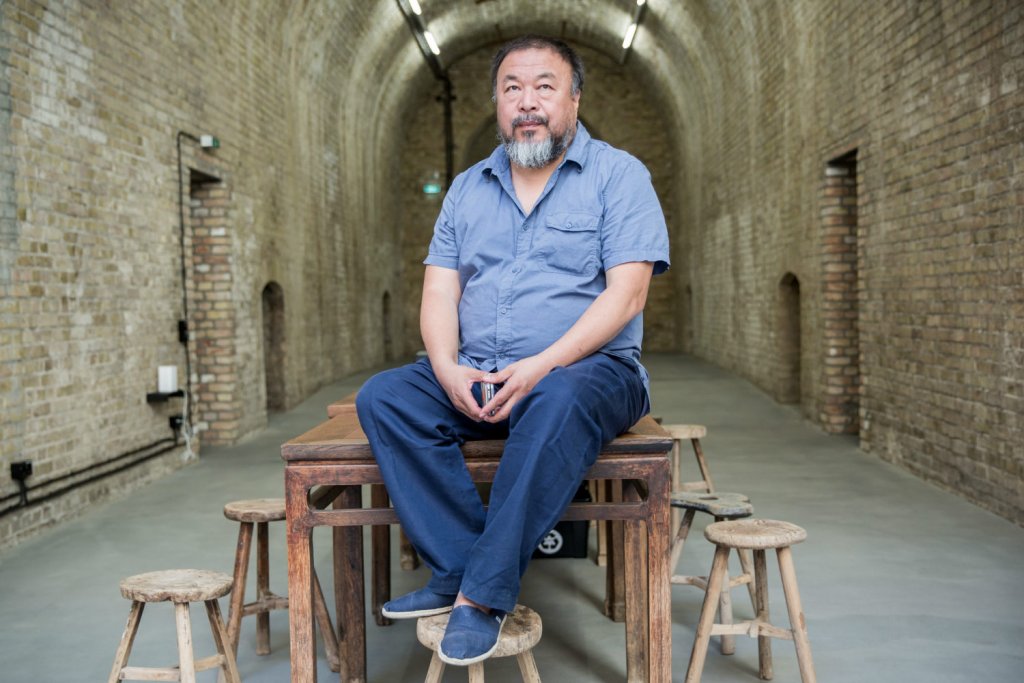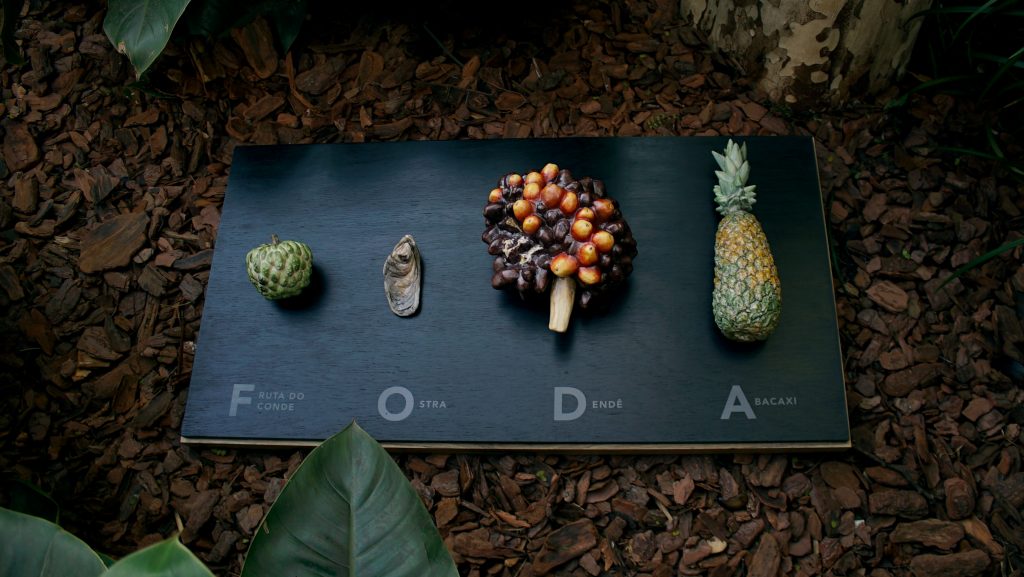RIO DE JANEIRO, BRAZIL – In theory, the largest Ai Weiwei exhibition circulating around Brazil starts this Wednesday, August 21st, in Rio. In practice, as of last week, those passing by the Centro Cultural Banco do Brasil (CCBB), have already seen and interacted with his most striking work.

Over nine meters tall and thirty meters long, the “Forever Bicycles” installation is on display in front of the Centro Cultural Banco do Brasil and the Church Candelária, where it forms a sort of tunnel for those who walk along the harbor waterfront and even a climber for the most daring children.
Built with more than one thousand bicycles, the work is dedicated to the principal means of transportation in the artist’s native country, particularly before the economic leap taken over the last thirty years, which has become part of the history of this show “Raiz” (root), designed in 2011 by curator Marcello Dantas, who invited the Chinese artist to reproduce here in Brazil his technique of collecting thousands, even millions of pieces, as in “Sunflower Seeds ” made with porcelain sunflower seeds, and painted by Chinese craftsmen.
Ai Weiwei was practically born in conflict with the Chinese government. In 1958, when he was one year old, he went to live in a forced labor camp with his father, the poet Ai Qing, sentenced to work cleaning restrooms for being a dissident of the revolution commanded nine years earlier by Mao Tsé-Tung. Weiwei only came out of exile at the age of seventeen — although exile has never left him.

While receiving the invitation to assemble his Brazilian version, Weiwei was living between detentions and house arrests — even though he helped to design the Beijing Olympic Stadium for the 2008 Games. In 2010, he was arrested and prevented from attending the banquet with 10,000 crabs that he organized to celebrate the demolition of his studio in Shanghai.
The number and the crustacean in large groups were symbols of Maoism and his concept of “harmony”. The Chinese Communist Party, which completes seven decades of dictatorship this year, did not like it at all. Forbidden to leave the country, he was arrested again in April 2011, when he was trying to board for Hong Kong.
That same year, he was investigated for “pornography” when he was shown in a photo with four naked women. Nevertheless, he exhibited his bicycles, which he also refers to as a symbol of freedom, in Taiwan — in the “Absent” exhibition, set up when China was trying to regain control over the island, which it never achieved.

Ai Weiwei only managed to leave China in 2015, at the age of 61, when he moved to Berlin where he currently lives. While maintaining political criticism, he keeps video teams in Hong Kong where protests are trying to uphold a relative freedom in relation to the Chinese central government, inherited from the former British rule.
The 60 works gathered in “Ai Weiwei — Raiz” bear the same concept of assembling repeated and/or similar elements. “Grapes” joins 32 wooden benches from the Qing Dynasty, through traditional Chinese carpentry techniques, while “Martin” and “Level” are part of the “Seven Roots” series, born out of roots dug up in Trancoso, Bahia, with the aim of cultural contexts in China and Brazil.
Not limited to politics, Weiwei’s provocation reaches the multiple objects made up of porcelain molds of four typicl Brazilian foods: sugar-apple, oyster, oil palm, and pineapple, spelling a slang word using the first letters of each, in order.
Handmade wooden sculptures from Juazeiro do Norte (Ceará State), leather works and the heraldic armory by Ariano Suassuna are also part of the exhibition, as well as stuffed pandas filled with copies of confidential documents leaked from the U.S. government.
Ai Weiwei – Raiz
Venue: Centro Cultural Banco do Brasil
August 21st to November 4th, from Wednesday to Monday, 9 AM to 9 PM
Address: Rua Primeiro de Março, 66, Centro (in front of Church Candelária), Rio de Janeiro
Tel.: +55 (21) 3808-2020
Free admission
Website: www.culturabancodobrasil.com.br/portal/rio-de-janeiro
More exhibitions on display
Rio – Energia em movimento (Energy in motion)
Another exhibition addressing city transformations, such as the demolition of Morro do Castelo. With old photos of Augustus Malta and recent photos by André Cyriaco, it depicts the arrival of services that are now common, such as lighting, transport, gas, and electricity, at the beginning of the 20th century.
Venue: Centro Cultural Light
Until August 30th, from Monday to Friday, from 9 AM to 7 PM
Address: Avenida Marechal Floriano 168, Central, Rio de Janeiro.
Paula Rocha – Espaços invisíveis (Invisible spaces)
Curated by Eduardo Guga Feijó, it features the artist’s paintings.
Venue: Galeria Modernistas
Until August 25th, Wednesday to Saturday, from 11 AM to 5 PM. Sunday, from 11 AM to 2 PM
Address: Rua Paschoal Carlos Magno 39, Santa Teresa, Rio de Janeiro.
Tel.:+55 (21) 3852-8265
Duo
The exhibition combines paintings by John Nicholson and photographs by Vanda Klabin in some fifty pieces.
Venue: Casa de Cultura Laura Alvim
Until August 25th, Tuesday to Sunday, from 1 PM to 8 PM
Address: Avenida Vieira Souto 176, Ipanema, Rio de Janeiro.
Tel.: +55 (21) 2332-2016
Linha de Montagem (Assembly Line)
Bruno Lins displays collages and paintings made over the past two years.
Venue: Centro Cultural Correios
Until August 25th, from Tuesday to Sunday, from 12 noon to 7 PM
Address: Rua Visconde de Itaboraí 20, near Candelária, downtown, Rio de Janeiro
Tel.: +55 (21) 2253-1580
Da linha, o fio (From the thread, the wire)
With 23 artists, including Pedro Varela, Rodrigo Mogiz, Laura Lydia, and Bispo do Rosário, the exhibition combines diverse techniques such as sculptures, installations, paintings, photographs, videos, drawings and objects that share the use of threads and wires.
Venue: Espaço Cultural BNDES
Until September 20th, Monday through Friday, from 10 AM to 7 PM
Address: Avenida Chile, 100, Carioca, Rio de Janeiro
Tel.: +55 (21) 2172-7447
Longevos (Longlives)
Flavio Shiró, Carlos Vergara, Anna Bella Geiger, Martha Pires Ferreira, Nelson Leiner, Regina Vater, and Thereza Miranda are among the artists, all more than sixty years old, using techniques ranging from painting to engraving, from drawing to photography.
Venue: Zagut
Until September 13th, Monday to Friday from 10 AM to 1 PM and from 2 PM to 6 PM. Saturday, only from 10 AM to 1 PM.
Address: Shopping Cassino Atlântico, Avenida Atlântica, 4240, store 315, Copacabana-Posto 6, Rio de Janeiro.
Tel.: +55 (21) 2235-5946
Em que espelho ficou perdida a minha face (In which mirror did my face get lost)
Curated by Marisa Flórido, Fernanda Leme exhibits paintings based on self-representation, particularly the current selfies.
Venue: IED – Istituto Europeo di Design
From Monday to Friday, from 11 AM to 10 PM. Saturdays, from 9 AM to 4 PM.
Address: Avenida João Luís Alves 13, Urca, Rio de Janeiro
Tel.: +55 (21) 3683-3786

